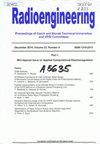结合RBF神经网络和极点残差传递函数的自定义响应微波结构参数化建模
IF 0.7
4区 工程技术
Q4 ENGINEERING, ELECTRICAL & ELECTRONIC
引用次数: 0
摘要
本文将RBF神经网络与基于极残差的传递函数相结合,提出了一种具有定制幅度响应的微波结构的参数建模技术。拉丁超立方体采样方法用于对给定的物理范围进行采样,并获得微波结构的EM行为。针对建模过程中出现的极点序列混沌和变序问题,提出了极点排序过程和改进的极点残差分裂过程。将上述预处理步骤后的极点残差参数用作RBF神经网络的输入,将物理参数用作RBF网络的输出。然后,利用微波结构的已知幅度响应作为先验知识,指导获得与给定幅度响应规范相对应的目标极点残差值。在RBF模型的训练过程之后,将目标极点残差输入到训练的RBF网络中,并获得与定制响应相对应的目标物理参数。最后,通过两个微波结构实例说明了该模型技术。本文章由计算机程序翻译,如有差异,请以英文原文为准。
Parametric Modeling of Microwave Structure with Customization Responses by Combining RBF Neural Network and Pole-Residue-Based Transfer Functions
. This paper proposed a parametric modeling technique for the microwave structures with a customization magnitude response by combining the RBF neural network and pole-residue-based transfer functions. The Latin hypercube sampling method is used for sampling given physical ranges and obtaining the EM behaviors of the microwave structures. A pole sorting process and a modified pole-residues splitting process are proposed to solve the pole sequence chaos and order-changing problems which occur in the modeling process. The pole-residues parameters after the above pre-processing steps are used as the inputs of the RBF neural network and the physical parameters are used as the outputs of RBF network. Then, the known magnitude response of the microwave structure are used as the prior knowledge to guide obtaining the goal pole-residues values corresponding to the giving magnitude response specification. After the training process of the RBF model, the goal pole-residues are input into the trained RBF network and the goal physical parameters corresponding to the customization responses is obtained. Finally, this model technique is illustrated by the two examples of microwave structures.
求助全文
通过发布文献求助,成功后即可免费获取论文全文。
去求助
来源期刊

Radioengineering
工程技术-工程:电子与电气
CiteScore
2.00
自引率
9.10%
发文量
0
审稿时长
5.7 months
期刊介绍:
Since 1992, the Radioengineering Journal has been publishing original scientific and engineering papers from the area of wireless communication and application of wireless technologies. The submitted papers are expected to deal with electromagnetics (antennas, propagation, microwaves), signals, circuits, optics and related fields.
Each issue of the Radioengineering Journal is started by a feature article. Feature articles are organized by members of the Editorial Board to present the latest development in the selected areas of radio engineering.
The Radioengineering Journal makes a maximum effort to publish submitted papers as quickly as possible. The first round of reviews should be completed within two months. Then, authors are expected to improve their manuscript within one month. If substantial changes are recommended and further reviews are requested by the reviewers, the publication time is prolonged.
 求助内容:
求助内容: 应助结果提醒方式:
应助结果提醒方式:


